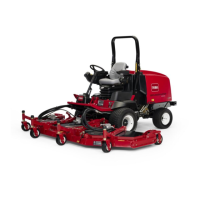Groundsmaster 4100--D/4110--D Hydraulic SystemPage 4 -- 49
Procedure for Piston (Traction) Pump Flow
Test
Thistestmeasures piston (traction) pump output(flow).
During this test, pump load is created at the flow meter
using the adjustable load valve on the tester.
IMPORTANT: Traction circuit flow for the
Groundsmaster4100/4110isapproximately3 0GPM
(113.5LPM).Use40GPMHydraulicTester#AT40002
(pressure and flow) for this test (see Special Tools
in this chapter).
1. Make sure hydraulic oil is at normal operating tem-
perature by operating the machine under load for
approximately ten (10) minutes. Make sure the hydrau-
lic tank is full.
2. Parkmachineonalevelsurfacewiththecuttingdeck
raisedandoff.Latchwingdecksinraisedposition.Make
sure that the Hi/Low switch is in the Low speed (4WD)
position. Shut off engine.
CAUTION
Prevent personalinjury and/or damage to equip -
ment. Read all WARNINGS, CAUTIONS and Pre-
cautions for Hydraulic Testing at the beginning
of this section.
3. Make sure that traction pedal is adjusted to the neu-
tral position. Also, ensure that traction pump is at full
stroke when traction pedal is pushed into fully forward
position.
4. Raise and support machine so all wheels are off the
ground(seeJackingInstructionsinChapter1 --Safety).
5. Thoroughly cleanjunctionofhydraulichose and left
side fitting on bottom of traction pump (forward port)
(Fig. 36). Disconnect hose from left side pump fitting.
6. Install 40 GPM Hydraulic Tester #AT40002 (pres-
sure and flow) in series between traction pump fitting
anddisconnectedhosetoallow flowfromtractionpump
totester.Usehydraulichosekit(seeSpecialToolsinthis
chapter)toconnecttestertomachine.Makesurethatfit-
tingandhose connections are properly tightened. Also,
make sure the flow control valve on tester is fully open.
CAUTION
Allwheelswillbeoffthegroundandrotatingdur-
ing this test. Make sure machine is supported so
itwillnotmoveandaccidentallyfalltopreventin-
juring anyone near the machine.
7. Startengineandrunatidlespeed.Checkforanyhy-
draulic leakage from tester and hose connections. Cor-
rect any leaks before proceeding.
8. Move throttle soengineisrunningathighidlespeed
(2870 RPM).
9. Slowly push traction pedal to fully forward position.
Keep pedal fully depressed in the forward position.
10.Havesecondpersoncarefullywatchpressuregauge
ontester whileslowlyclosingtheflowcontrol v alve until
1000PSI(69bar)isobtained.Verifywithaphototacthat
the engine speed is still 2870 RPM.
NOTE: If engine speed drops below 2870 RPM, pump
flow will decrease.
11.Observe flow gauge. Flow indication should be
approximately 29 GPM (110 LPM).
12.Release traction pedal to the neutral position, open
flow control valve on tester and shut offengine. Record
test results.
13.If flow is less than 26 GPM (98 LPM), consider the
following:
A. The traction pump swash plate is not being ro-
tated fully (e.g. Hi/Low switch is not in Low speed
(4WD), traction pedal linkage may need adjust-
ment).
B. The hydrostat needs to be repaired or replaced
as necessary.
14.Makenecessaryrepairsbeforeperforminganyaddi-
tional tests.
15.When testing is complete, disconnect tester and
hose kit from pump fitting and machine hydraulic hose.
Reconnectmachinehydraulichosetopumpfitting.Low-
er machine to ground.
1. Piston (traction) pump 2. LH fitting (forward port)
Figure 36
FRONT
RIGHT
1
2
Hydraulic
System

